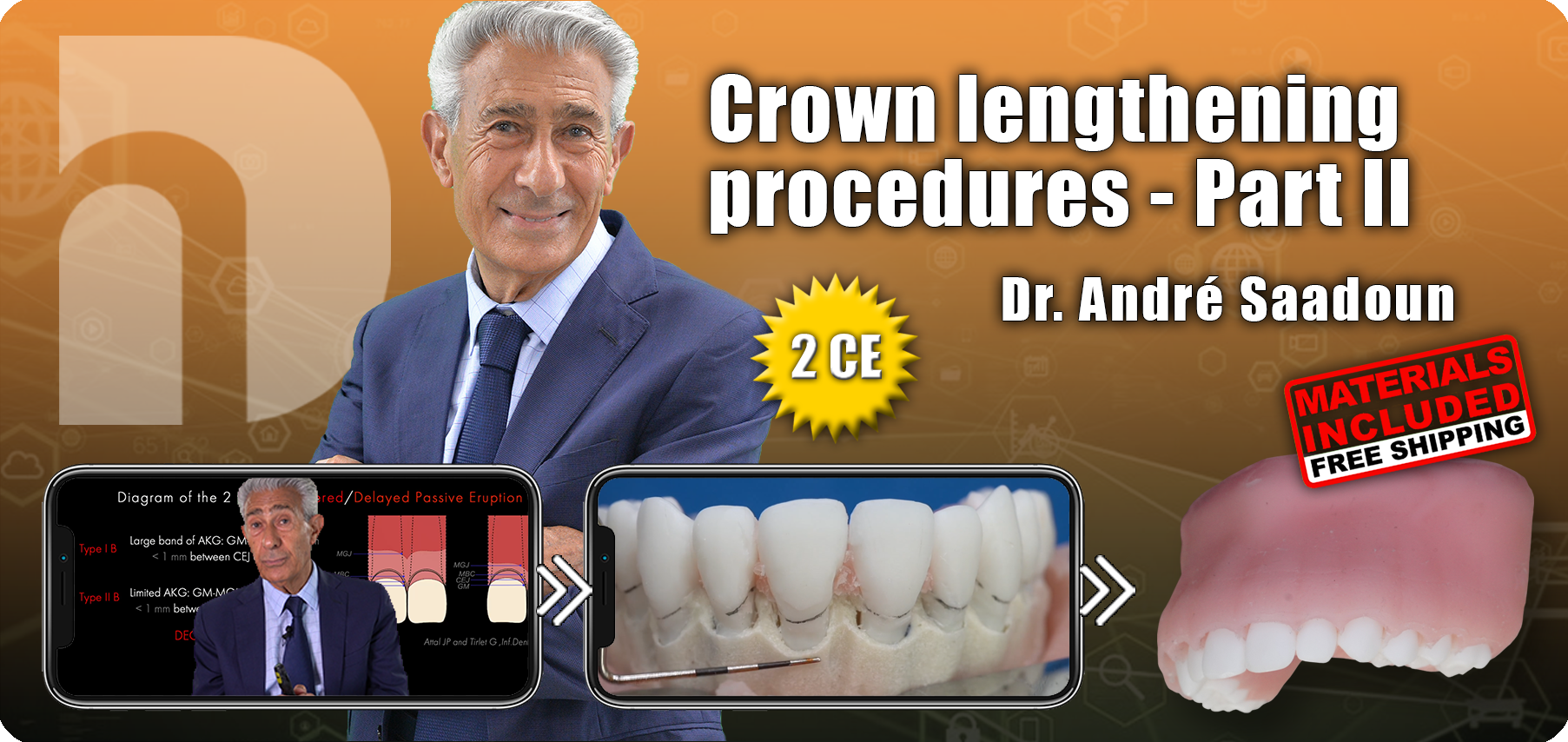Crown Lengthening Procedures: Diagnosis, Classification and Clinical Applications PART II: Delayed Passive Eruption Gingival Smile Type I B (with Bone Crest at the CEJ)
 General Information
General Information
Date: Published on 22/02/22
Last Review: 14/06/24
Location: Online
Teaching method: Self-instructional (The student will have the opportunity to watch the pre-recorded lecture, the pre-recorded workshop, and then practice at home with the materials that we will send him)
Continuing Educational Credits Awarded: 2CE
Dentalhow.online is an ADA CERP Recognized Provider.
ADA CERP is a service of the American Dental Association to assist dental professionals in identifying quality providers of continuing dental education. ADA CERP does not approve or
endorse individual courses or instructors, nor does it imply acceptance of credit hours by boards of dentistry.
Dentalhow.online designates this activity for 2 continuing education credits.
*You can watch the lecture & workshops as many times as you want, there isn’t any kind of expiration date*
*Dr. André Saadoun has no conflicts of interest related to this course. He does not have any relevant financial relationships to declare.*
If you wish to ask a question, share a clinical case relevant to the course topic, or request additional information regarding the scientific content, please feel free to contact us at info@dentalhow.online
If you require any technical assistance or support, please feel free to send a message by using the green chat box located on the right side of the main screen, this will send you directly to our WhatsApp number where you’ll be attended.
 Abstract
Abstract
The Crown Lengthening Surgical techniques are multiples and are dependent on the Initial Situation and the Objective to achieve.
These procedures have in general an Esthetic, a Biologic and Bio-mechanical objectives and could be a combination of them in Complex Cases.
Gingival Smile can result from different abnormalities, and is often a Combination of several ones.
Since the Gingival Smile is of multifactorial origin, it cannot be until Esthetic and Etiological Diagnosis have been established.
Crown Lengthening Procedure, is a Surgical treatment modality to achieve the apically repositioning of the Biological Width, to increase the height of the teeth, create the normal teeth proportion, harmonize the Gingival contours, treat the Gingival Smile, reestablish a healthy tooth structure on Broken teeth.
Establishing an Adequate Classification and a Correct Diagnosis, would definitely help the clinician to choose the most appropriate Surgical Procedure to prevent any recurrence of the Soft Tissue over the teeth and achieve an optimal esthetic Result.
The utilization of CBCT, Digital Dental Smile and CAD CAM Digital Workflow, have change dramatically establishing a more precise diagnosis and using of a new Type of Surgical Guide to perform the surgery in a more precise and minimal way.
The new Biological Width will take about 6 months to heal, histologically which suggest to wait this minimum time to restore any teeth in the esthetic zone.
Therefore, restoring the normal biological width is the principal objective at the end of each surgical session to prevent recurrence of the excess of soft tissue and esthetic complications.
The objective of this presentation is to establish a precise diagnosis for a well-planned surgical strategy using the conventional or digital approach with a surgical guide, in order to give a satisfactory smile to the patient as defined in treatment plan.
PART II: Delayed Passive Eruption Gingival Smile Type I B (With Bone Crest at 0-0,5 mm from the CEJ)
 Course Content
Course Content
- Online Pre-recorded lecture | 1 h
- Online Pre-recorded workshop | 40 min
- Customized BoneModel (BM)
IMPORTANT – Experience in this area is recommended to ensure a good understanding of the course content.
DIFFICULTY – MEDIUM
*THIS IS THE SECOND PART OF A TWO PARTS COURSE, YOU CAN TAKE THEM INDIVIDUALLY BUT WE RECOMMEND TO PURCHASE BOTH*
*We only send the components specified in the “Do It” segment, the rest of the material needed to perform the workshop (such as drills, blades, sutures, etc) will be provided by the student*
TAXES AND SHIPPING INCLUDED
 Why should I take this course?
Why should I take this course?
Improved treatment outcomes: Without proper training in crown lengthening procedures, dental professionals may not be able to provide the best possible care for patients who require this type of treatment. Taking a course in crown lengthening procedures can help professionals improve patient outcomes and provide better overall care.
Better patient satisfaction: With improved patient outcomes, patients are more likely to be satisfied with their treatment and experience less discomfort, which can lead to increased patient loyalty and positive word-of-mouth recommendations.
Increased expertise: By taking a course in crown lengthening procedures, professionals can increase their expertise and knowledge in this area, allowing them to provide more advanced treatments and improve their overall skillset.
Better patient communication: With a deeper understanding of crown lengthening procedures, professionals can better communicate the nature of a patient’s condition and the potential risks and benefits of treatment, leading to improved patient engagement and participation in their care.
Increased marketability: As more and more patients seek out dental professionals with expertise in crown lengthening procedures, taking a course in this area can increase a professional’s marketability and competitiveness in the field, allowing them to stand out from their peers and attract new patients.





